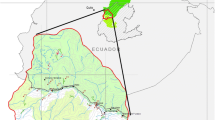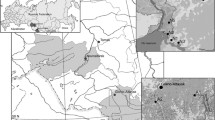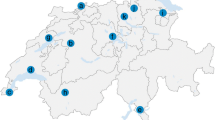Abstract
Two urban and two suburban biotopes of Tomsk were studied for tick-transmitted disease prevalence in ticks collected in the wild. Tick-borne encephalitis virus (TBEV), West Nile virus (WNV), Borrelia spp., Rickettsia spp., and Ehrlichia spp. were found in 6.5%, 2.2%, 8%, 2.5%, and 1.7% of tick specimens, respectively. Genetic markers of Powassan virus, Bartonella spp., and Babesia spp. were not found. Analysis of the genetic diversity of revealed pathogens demonstrated that TBEV strains belonged to the Siberian and Far-Eastern subtypes, and the Far-Eastern subtype of TBEV is most frequently found in urban biotopes (up to 43% of urban strains of TBEV). WNV strains belonged to the 1a genotype. Borrelia spp. was classified as B. garinii, Rickettsia spp. was classified as R. tarasevichiae and probably as a new Rickettsia raoultii subspecies, and Ehrlichia spp. was classified as E. muris. The coexistence of several pathogens was found in 5.7% of tick specimens, and TBEV + Borrelia spp. was the most frequent combination.
Similar content being viewed by others
References
Alekseev, A.N., Dubinina, H.V., and Jushkova, O.V., “First Report on the Coexistence and Compatibility of Seven Tick-borne Pathogens in Unfed Adult Ixodes persulcatus Schulze (Acarina: Ixodidae),” Int. J. Med. Microbiol. 293(37), 104–108 (2004).
Burkot, T.R., Schneider, B.S., Pieniazek, N.J., Happ, C.M., et al., “Babesia microti and Borrelia bissettii Transmission by Ixodes spinipalpis Ticks Among Prairie Voles, Microtus ochrogaster, in Colorado,” Parasitology 121, 595–599 (2000).
Chang, C.C., Hayashidani, H., Pusterla, N., Kasten, R.W., et al., “Investigation of Bartonella Infection in Ixodid Ticks from California,” Comp. Immunol. Microbiol. Infect. Dis. 25, 229–236 (2002).
Chunikhin, S.P., Srephutkina, L.F., Korolev, M.B., et al., “Sex Transmission of the Tick-Borne Encephalitis Virus in Ixodid Ticks,” Parazitologyia 17(3), 214–217 (1983).
Fomenko, N.V., Sabitova, Yu.V., Khasnatdinov, M.A., et al., “Heterogeneity of the p83/100 Gene in the Borrelia burgdorferi sensu lato Complex,” Molecular Genetics, Microbiology, and Virology, No. 4, 31–37 (2007).
Gritsun, T.S., Lashkevich, V.A., and Gould, E.A., “Tick-borne Encephalitis,” Antiviral Res. 57, 129–146 (2003a).
Gritsun, T.S., Frolova, T.V., Zhankov, A.I., Armesto, M., et al., “Characterization of a Siberian Virus Isolated from a Patient with Progressive Chronic Tick-borne Encephalitis,” J. Virol. 77(1) 25–36 (2003b).
Guthrie. A.J., Howell. P.G., Gardner. I.A., Swanepoel, R.E., et al., “West Nile Virus Infection of Thoroughbred Horses in South Africa (2000–2001),” Equine Vet. J. 35(6), 601–605 (2003).
Hilpertshauser, H., Deplazes, P., Schnyder, M., Gern, L., et al., “Babesia spp. Identified by PCR in Ticks Collected from Domestic and Wild Ruminants in Southern Switzerland,” Appl. Environ Microbiol. 72(10), 6503–6507 (2006).
Karbowiak, G., Stanko, M., Rychlik, L., Nowakowski, W., et al., “The New Data About Zoonotic Reservoir of Babesia microti in Small Mammals in Poland,” Acta Parasitologica 44, 142–144 (1999).
Kim, C.M., Kim, J.Y., Yi, Y.H., Lee, M.J., et al., “Detection of Bartonella Species from Ticks, Mites and Small Mammals in Korea,” J. Vet. Sci. 6(4), 327–334 (2005).
Kononova, Yu.V., Ternovoi, V.A., Shchelkanov, M.Yu., et al., “Genotyping of the West Nile Virus in Populations of Wild Birds Dwelling on Ground and in Tree-Shrub Complex of Vegetation in Barabinsk Forest-Steppe and Kulunda Steppe (2003–2004),” Voprosy Virusologii 51(4), 19–23 (2006).
Korenberg, E.I., “Mixed Infections Transmitted by Ixodid Ticks: Actual Aspects of Their Study and Prophylaxis,” in Tick-Borne Encephalitis, Ed. by Leonova, G.N. and Somova-Isachkova, L.M. (Vladivostok, 2002) [in Russian].
Korenberg, E.I., Gorelova, N.B., and Kovalevskii, Yu.V., “The Main Features of the Natural Foci of Tick-Borne Borrelioses in Russia,” Parazitologiya 36(3), 177–191 (2002).
Korenberg, E., Likhacheva. T., “Analysis of the Longterm Dynamics of Tick-borne Encephalitis (TBE) and Ixodid Tick-borne Borrelioses (ITBB) Morbidity in Russia,” Int. J. Med. Microbiol. 296(S1), 54–58 (2006).
Lanciotti, R.S., Ebel, G.D., Deubel, V., Kerst, A.J., et al., “Complete Genome Sequences and Phylogenetic Analysis of West Nile Virus Strains Isolated from the United States, Europe, and the Middle East,” Virology 298(1), 96–105 (2002)
Leonova, G.I., Isachkova, L.M., Baranov, N.I., and Kruglyak, S.P., “The Study of the Role of Powassan Virus in the Etiological Structure of Tick-borne Encephalitis in Primorskii Territory,” Voprosy Virusologii 2, 173–176 (1980).
Mackenzie, J. S., Smith, D.W., Hall, R.A., “West Nile Virus: is There a Message for Australia,” Med. J. Australia 178(1), 5–6 (2003).
Majlathova, V., Majlath, I., Derdakova, M., et al., “Borrelia lusitaniae and Green Lizards (Lacerta viridis), Karst Region, Slovakia,” Emerg. Infect. Dis. 12, 1895–1901 (2006).
Mediannikov, O.Y., Sidelnikov, Y., Ivanov, L., Mokretsova, E., et al., “Acute Tick-borne Rickettsiosis Caused by Rickettsia heilongjiangensis in the Russian Far East,” Emerg. Infect. Dis. 10(5), 810–817 (2004).
Morales, M.A., Barrandeguy, M., Fabbri, C., Garcia, J.B., et al., “West Nile Virus Isolation from Equines in Argentina,” Emerg. Infect. Dis. 12, 1559–1561 (2006).
Morozova, O.V., Cabello, F.C., and Dobrotvorsky, A.K. “Seminested PCR Detection of Bartonella henselae in Ixodes persulcatus Ticks from Western Siberia, Russia,” Vector Borne Zoonotic Dis. 4, 306–309 (2004).
Moskvitina, N.S., Romanenko, V.N., Ternovoi, V.A., et al., “Revealing of the West Nile Virus and Its Genotyping in Ixodid Ticks (Parasitiformes: Ixodidae) in Tomsk and Suburbs,” Parazitologiya 42(3), 210–225 (2008).
Onishchenko, G.G., Fedorov, Yu.M., and Pakskina, N.D., “Organization of Tick-Borne Encephalitic Control and Prophylaxis of This Disease in the Russian Federation,” Voprosy Virusologii 52(5), 8–10 (2007).
Peenen, P.F. van, Chang, S.J., Banknieder, A.R., and Santana, F.J., “Piroplasms from Taiwanese Rodents,” J. Protozool. 24, 310–312 (1977).
Shpynov, S., Fournier, P.E., Rudakov, N.V., Tankibaev, M., et al., “Detection of a Rickettsia Closely Related to Rickettsia aeschlimannii, “Rickettsia heilongjiangensis,” Rickettsia sp. Strain RpA4, and Ehrlichia muris in Ticks Collected in Russia and Kazakhstan,” J. Clin. Microbiol. 42(5), 2221–2223 (2004).
Shpynov, S., Fournier, P.E., Rudakov, N.V., Samoilenko, I.E., et al., “Short Report: Molecular Identification of a Collection of Spotted Fever Group Rickettsiae Obtained from Patients and Ticks from Russia,” Am. J. Trop. Med. Hyg. 74(3), 440–443 (2006).
Smith, R.P., Muzaffar, S.B., Lavers, J., Lacombe, J.H., et al., “Borrelia garinii in Seabird Ticks (Ixodes uriae), Atlantic Coast, North America,” Emerg. Infect. Dis. 12, 1909–1912 (2006).
Stronin, O.V., Shutova, N.A., Petrov, E.Yu., Khasnatinov, M.A., Belikov, S.I., Kulikov, V.N., and Andreichuk, Yu.V., “Isolation and Typing of Agents of Ixodid Tick-borne Borrelioses in the Territory of Tomsk Province,” in Proceedings of the All-Russia Conference “Clinical Infections Prospective” (St. Petersburg, 2001).
Suss, J., “Epidemiology and Ecology of TBE Relevant to the Production of Effective Vaccines,” Vaccine 21(S1), 19–35 (2003).
Tabara, K., Arai, S., Kawabuchi, T., Itagaki, A., et al., “Molecular Survey of Babesia microti, Ehrlichia Species and Candidatus Neoehrlichia micurensis in Wild Rodents from Shimane Prefecture, Japan,” Microbiol. Immunol. 51(4), 359–367 (2007).
Temporary Instructions on Methods of the Study of Natural Foci of the Tick-Borne Encephalitis and Estimation of the Efficiency of Its Control (Moscow, inzdrav RSFSR, 1959) [in Russian].
Ternovoi, V.A., Shchelkanov, M.Yu., Shestopalov, A.M. et al., “Revealing of the West Nile Virus in Birds in Barabinsk and Kulunda Lowlands (Western Siberian Bird Route) in Summer and Spring of 2002),” Voprosy Virusologii 49(3), 52–56 (2004).
Ternovoi, V.A., Protopopova, E.V., Surmach, S.G., et al., “Genotyping of the West Nile Virus Revealed in Birds of Southern Primorskii Territory in 2002–2004,” Molecular Genetics, Microbiology, and Virology, No. 4, 30–35 (2006).
Ternovoi, V.A., Protopopova, E.V., Kononova, Yu.V., et al. “West Nile Fever in Novosibirsk Province in 2004 and Genotyping of the Virus Transmitters,” Vestnik RAMN, No. 1, 21–26 (2007).
Tsai, T.F. “Arboviral Infections in the United States,” Infect. Dis. Clin. North. Am. 5, 73–102 (1991).
Zamoto, A., Tsuji, M., Wei, Q., Cho, S.H., et al., “Epizootiologic Survey for Babesia Microti Among Small Wild Mammals in Northeastern Eurasia and a Geographic Diversity in the β-tubulin Gene Sequences,” J. Vet. Med. Sci. 66(7), 785–792 (2004).
Zlobin, V.I., Verkhozina, M.M., Demina, T.V., et al., “Molecular Epidemiology of the Tick-Borne Encephalitis,” Voprosy Virusiologii 52(6), 4–13 (2007).
Author information
Authors and Affiliations
Corresponding author
Additional information
Original Russian Text © E.V. Chausov, V.A. Ternovoi, E.V. Protopopova, S.N. Konovalova, Yu.V. Kononova, N.L. Pershikova, N.S. Moskvitina, V.N. Romanenko, N.V. Ivanova, N.P. Bolshakova, S.S. Moskvitin, I.G. Korobitsin, S.I. Gashkov, O.Yu. Tiutenkov, V.N. Kuranova, L.B. Kravchenko, N.G. Suchkova, L.P. Agulova, V.B. Loktev, 2009, published in Parazitologiya, 2009, Vol. 43, No. 5, pp. 374–388.
Rights and permissions
About this article
Cite this article
Chausov, E.V., Ternovoi, V.A., Protopopova, E.V. et al. Genetic diversity of tick-borne pathogenes in Tomsk and environs. Entmol. Rev. 90, 240–250 (2010). https://doi.org/10.1134/S0013873810020090
Received:
Published:
Issue Date:
DOI: https://doi.org/10.1134/S0013873810020090




